![]()
![]()
![]()
Use LEFT and RIGHT arrow keys to navigate between flashcards;
Use UP and DOWN arrow keys to flip the card;
H to show hint;
A reads text to speech;
25 Cards in this Set
- Front
- Back
|
ROM Test:
•Test 2: Shoulder Flexion with Internal Rotation Muscle Test: 10A-1 •Deltoid tests are similar, Anterior deltoid is just rotated internally to give them the moment arm. •Patient supine, 90º elbow flexion •75º humeral flexion, 45º abduction, 10º internal rotation Tester: •FORCE: Adduct and extend through oblique plane (Press down & in, back to starting position). Palpation/Function: •If one is weak, treat as a whole •The “Deltoids” function as a whole: Assists in every motion of the shoulder. Becomes shortened with supraspinatus in a depressed shoulder alignment. When short: Glenohumeral joint becomes abducted. To compensate, the shoulders become depressed and downwardly rotate drawing the arms into the thorax. •Anterior Division: Assist in horizontal adduction, & Flex and internally rotate humerus. Clavicle (Anterior/Lateral ½) •Supine, palpate along anterior lateral ½ of clavicle into the outer to anterior surface of the acromion process. •All the way over to where you feel the acromion curve around to the lateral surface. (Middle deltoid on lateral surface). Deltoid Tuberosity (Anterior Surface) •Palpate anterior surface of the deltoid tuberosity (on humerus) •Come halfway down the humerus, find bump, and treat the anterior aspect. •Have them push into your arm to help find the anterior surface of bump. |
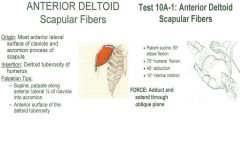
Anterior Deltoid:
Scapular Fibers |
|
|
ROM Test:
•Test 2: Shoulder Flexion with Internal Rotation Muscle Test: 10A-2 •Patient supine, 90º elbow flexion •75º humeral flexion, 45º abduction, Externally rotate humerus 10º Tester: •FORCE: Adduct and slightly extend arm obliquely on shoulder •Same test as Scapular fibers except with external rotation. Palpation/Function: •If one is weak, treat as a whole •The “Deltoids” function as a whole: Assists in every motion of the shoulder. Becomes shortened with supraspinatus in a depressed shoulder alignment. When short: Glenohumeral joint becomes abducted. To compensate, the shoulders become depressed and downwardly rotate drawing the arms into the thorax. •Anterior Fibers: Assist in horizontal adduction, & Flex and internally rotate humerus. Clavicle (Anterior/Lateral ½) •Supine, palpate along anterior lateral ½ of clavicle into the outer to anterior surface of the acromion process. •All the way over to where you feel the acromion curve around to the lateral surface. (Middle deltoid on lateral surface). Deltoid Tuberosity (Anterior Surface) •Palpate anterior surface of the deltoid tuberosity (on humerus) •Come halfway down the humerus, find bump, and treat the anterior aspect. •Have them push into your arm to help find the anterior surface of bump |
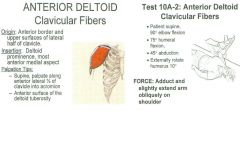
Anterior Deltoid:
Clavicular Fibers |
|
|
ROM Test:
Muscle Test: 10B •Patient supine, 90º elbow flexion •Abduct humerus 90º •Slight internal rotation Tester: •FORCE: Adduct humerus through coronal plane (From a superior angle, push down toward feet) Palpation/Function: •The “Middle” Deltoid is the most LATERAL of all the deltoids! It’s not the “medial deltoid!” •If one tests weak, treat as a whole. •The “Deltoids” function as a whole: Assists in every motion of the shoulder. Becomes shortened with supraspinatus in a depressed shoulder alignment. • When short: Glenohumeral joint becomes abducted. To compensate, the shoulders become depressed and downwardly rotate drawing the arms into the thorax. Acromion Process •Supine, palpate along lateral aspect of shoulder across acromion. •Lateral aspect of acromion process, palpate laterally •Find spine of scapula, go to lateral angle of the posterior aspect of acromion, follow right across into the lateral aspect of the acromion. Deltoid Tuberosity (Lateral Surface) •Lateral surface of the deltoid tuberosity. •Come halfway down the humerus, find bump, and treat the lateral aspect. |
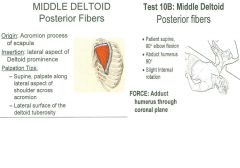
Middle Deltoid:
Posterior Fibers |
|
|
ROM Test:
Muscle Test: 10B •Patient supine, 90º elbow flexion •Abduct humerus 90º •Slight external rotation Tester: •FORCE: Adduct humerus through coronal plane. Palpation/Function: •The “Middle” Deltoid is the most LATERAL of all the deltoids! It’s not the “medial deltoid!” •If one tests weak, treat as a whole. •The “Deltoids” function as a whole: Assists in every motion of the shoulder. Becomes shortened with supraspinatus in a depressed shoulder alignment. • When short: Glenohumeral joint becomes abducted. To compensate, the shoulders become depressed and downwardly rotate drawing the arms into the thorax. Acromion Process •Supine, palpate along lateral aspect of shoulder across acromion. •Lateral aspect of acromion process, palpate laterally •Find spine of scapula, go to lateral angle of the posterior aspect of acromion, follow right across into the lateral aspect of the acromion. Deltoid Tuberosity (Lateral Surface) •Lateral surface of the deltoid tuberosity. •Come halfway down the humerus, find bump, and treat the lateral aspect. |
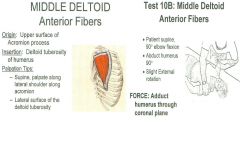
Middle Deltoid: Anterior Fibers
|
|
|
ROM Test:
•Test 1: Shoulder Flexion with Full Abduction •Test 4: 90/90 Internal Rotation •Test 6: 90/90 External Rotation •Test 10: Internal Rotation at 110º of Abduction Muscle Test: 10C •Patient supine, 90º elbow flexion •90º abduction, with full internal rotation of humerus •Extend arm 20º Tester: •FORCE: Adduct arm on shoulder •Get superior, push arm toward feet. Palpation/Function: •Treat as a whole if one is weak •Posterior Fibers: Extends and externally rotates the humerus. •Horizontally abducts humerus. •Abduction with humerus internally rotated. •Posterior Deltoid can become dominant as an external rotator if: Weakness of teres minor and Infraspinatus, combines pull of rotation and extension, creates anterior glide on the humeral head. Spine of Scapula •Supine, palpate along inferior, medial ½ of the spine of the scapula •Find acromion, then find spine of scapula, come under spine, and work along the inferior aspect, curling up into the inferior aspect of the spine of the scapula. •Curling into inferior aspect, treat entire inferior aspect of spine •Pressure: up and in Deltoid Tuberosity (Posterior Surface) •Palpate the posterior surface of the deltoid tuberosity. •Come halfway down the humerus, find bump, & treat the posterior aspect. •Have them abduct into your arm to help find deltoid tuberosity. |
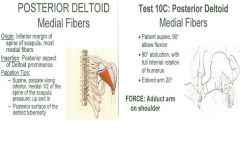
Posterior Deltoid: Medial Fibers
|
|
|
ROM Test:
•Test 1: Shoulder Flexion with Full Abduction •Test 4: 90/90 Internal Rotation •Test 6: 90/90 External Rotation •Test 10: Internal Rotation at 110º of Abduction Muscle Test: 10C •Patient supine, 90º elbow flexion •90º abduction •Fully internally rotate humerus Tester: •FORCE: Adduct arm on shoulder •Get superior, push arm towards feet Palpation/Function: •Treat as a whole if one is weak. •Posterior Fibers: Extends and externally rotates the humerus. •Horizontally abducts humerus. •Abduction with humerus internally rotated. •Posterior Deltoid can become dominant as an external rotator if: Weakness of teres minor and Infraspinatus, combines pull of rotation and extension, creates anterior glide on the humeral head. Spine of Scapula •Supine, palpate along inferior, medial ½ of the spine of the scapula •Find acromion, then find spine of scapula, come under spine, and work along the inferior aspect, curling up into the inferior aspect of the spine of the scapula. •Curling into inferior aspect, treat entire inferior aspect of spine •Pressure: up and in Deltoid Tuberosity (Posterior Surface) •Palpate the posterior surface of the deltoid tuberosity. •Come halfway down the humerus, find bump, & treat the posterior aspect. •Have them abduct into your arm to help find deltoid tuberosity. |
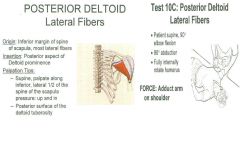
Posterior Deltoid:
Lateral Fibers |
|
|
ROM Test:
•Test 10: Internal Rotation at 110º of Abduction •Test 11: Adduction with Internal Rotation Muscle Test: 11A •Patient supine, 45º abduction •Full internal rotation of humerus Tester: •FORCE: Adduct through coronal plane. Palpation/Function: •Supraspinatus should be the last thing tested/treated. If the scapula is unstable and you test it, the scapula will downwardly rotate and you will impinge it which will cause a lot of pain. •Initiates abduction of arm. •Depresses and stabilizes the head of humerus inward toward glenoid. •Slight flexion and internal rotation of humerus. •Vulnerable to injury when the shoulder is depressed. Supraspinatus Fossa •Supine, palpate through upper trapezius into supraspinatus fossa. •Use the spine of scapula as landmark, find spine, come anterior, and try to go down into the fossa. Have to use a lot of pressure because you have to go through the belly of supraspinatus to get to the bone. Try to fill in as much as you can until you hit the back of the clavicle. •Treat the ENTIRE supraspinatus fossa. •Anterior to spine of scapula Greater Tubercle of Humerus •Palpate under acromion onto greater tubercle. •Anterior to acromion •Find acromion process, there will be a split in the deltoid, internally rotate the arm, come right in between the split right on the head of the humerus just anterior to the acromion process. •Find anterior/middle deltoid split, internally rotate the humerus, Greater tubercle of the humerus will come right to you. |
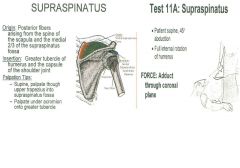
Supraspinatus:
|
|
|
ROM Test:
•Test 5: External Rotation with Humeral Adduction •Test 6: 90/90 External Rotation Muscle Test: 12 •Patient supine, 90º elbow flexion •Adduct, full external rotation Tester: •FORCE: Internally rotate arm on shoulder Palpation/Function: •4 Rotator Cuff Muscles: Teres Major/Minor, Infraspinatus, Supraspinatus, & Subscapularis •Located Just above the Teres Major •External rotation and depression of the humeral head. •Works with Infraspinatus during elevation to stabilize humerus. Axillary Border (Posterior/Upper 2/3) •Prone, palpate upper 2/3 of posterior axillary border above teres major attachment. •You’ll feel where Teres Major starts to pick up, its normally huge. •Outline the scapula, start at axillary border palpating superior to inferior on lateral border. Greater Tubercle of Humerus •Palpate deep into posterior greater tubercle inferior to Infraspinatus. •Pay attention to where head of humerus is, take them into full flexion, take their arm, find acromion drop off acromion onto head of humerus, head of humerus will fall out underneath the deltoid, find the head of the humerus, move it back and forth, the more flexion they are in, the more the head of the humerus is towards you. Come into the posterior aspect of the head of the humerus. •Find tip of acromion, drop inferior and medial |
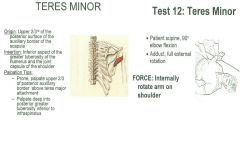
Teres Minor:
|
|
|
ROM Test:
•Test 5: External Rotation with Humeral Adduction •Test 6: 90/90 External Rotation Muscle Test: 13A •Patient supine, 90º elbow flexion •30º abduction, full external rotation Tester: •FORCE: Internally rotate arm on shoulder Palpation/Function: •Treat as a whole, the whole Infraspinatus fossa. •Infraspinatus Function: Externally rotates humerus. •Holds head of humerus in glenoid fossa (depressing the humeral head). •If tight: may be a contributor to mid-scapular tension, and will contribute to excessive anterior glide of the humeral head contributing to impingement. •Pain associated is usually in anterior shoulder. Infraspinatus Fossa •Prone, palpate upper ¼ of Infraspinatus fossa and along vertebral border. •Fill in the entire Infraspinatus fossa •Start out at root, work way over to posterior aspect laterally; work back and forth all the way down. Greater Tubercle of Humerus •Similar to Teres Minor, but superior •Flex arm to bring attachment posterior. Palpate deep into posterior greater tubercle. •Drop off acromion inferior and then 1 finger width down and 1 finger width lateral •Palm forward. |
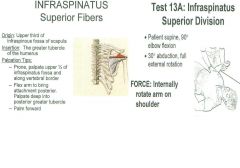
Infraspinatus:
Superior Fibers |
|
|
ROM Test:
•Test 5: External Rotation with Humeral Adduction •Test 6: 90/90 External Rotation Muscle Test: 13B •Patient supine, 90º elbow flexion •60º abduction, full external rotation Tester: •FORCE: Internally rotate arm on shoulder Palpation/Function: •Treat as a whole, the whole Infraspinatus fossa. •Infraspinatus Function: Externally rotates humerus. •Holds head of humerus in glenoid fossa (depressing the humeral head). •If tight: may be a contributor to mid-scapular tension, and will contribute to excessive anterior glide of the humeral head contributing to impingement. •Pain associated is usually in anterior shoulder. Infraspinatus Fossa •Prone, palpate upper ¼ of Infraspinatus fossa and along vertebral border. •Fill in the entire Infraspinatus fossa •Start out at root, work way over to posterior aspect laterally; work back and forth all the way down. Greater Tubercle of Humerus •Similar to Teres Minor, but superior •Flex arm to bring attachment posterior. Palpate deep into posterior greater tubercle. •Drop off acromion inferior and then 1 finger width down and 1 finger width lateral •Palm forward. |
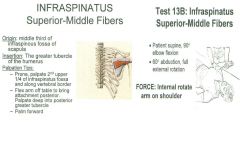
Infraspinatus:
Superior-Middle Fibers |
|
|
ROM Test:
•Test 5: External Rotation with Humeral Adduction •Test 6: 90/90 External Rotation Muscle Test: 13C •Patient supine, 90º elbow flexion •90º abduction, full external rotation Tester: •FORCE: Internally rotate arm on shoulder Palpation/Function: •Treat as a whole, the whole Infraspinatus fossa. •Infraspinatus Function: Externally rotates humerus. •Holds head of humerus in glenoid fossa (depressing the humeral head). •If tight: may be a contributor to mid-scapular tension, and will contribute to excessive anterior glide of the humeral head contributing to impingement. •Pain associated is usually in anterior shoulder. Infraspinatus Fossa •Prone, palpate upper ¼ of Infraspinatus fossa and along vertebral border. •Fill in the entire Infraspinatus fossa •Start out at root, work way over to posterior aspect laterally; work back and forth all the way down. Greater Tubercle of Humerus •Similar to Teres Minor, but superior •Flex arm to bring attachment posterior. Palpate deep into posterior greater tubercle. •Drop off acromion inferior and then 1 finger width down and 1 finger width lateral •Palm forward. |
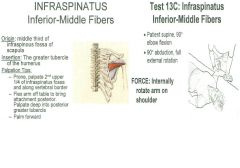
Infraspinatus:
Inferior-Middle Fibers |
|
|
ROM Test:
•Test 5: External Rotation with Humeral Adduction •Test 6: 90/90 External Rotation Muscle Test: 13D •Patient supine, 90º elbow flexion •120º abduction, full external rotation Tester: •FORCE: Internally rotate arm on shoulder. Palpation/Function: •Treat as a whole, the whole Infraspinatus fossa. •Infraspinatus Function: Externally rotates humerus. •Holds head of humerus in glenoid fossa (depressing the humeral head). •If tight: may be a contributor to mid-scapular tension, and will contribute to excessive anterior glide of the humeral head contributing to impingement. •Pain associated is usually in anterior shoulder. Infraspinatus Fossa •Prone, palpate upper ¼ of Infraspinatus fossa and along vertebral border. •Fill in the entire Infraspinatus fossa •Start out at root, work way over to posterior aspect laterally; work back and forth all the way down. Greater Tubercle of Humerus •Similar to Teres Minor, but superior •Flex arm to bring attachment posterior. Palpate deep into posterior greater tubercle. •Drop off acromion inferior and then 1 finger width down and 1 finger width lateral •Palm forward. |
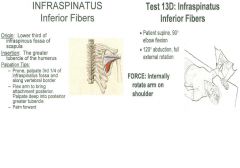
Infraspinatus:
Inferior Fibers |
|
|
ROM Test:
•Test 4: 90/90 Internal Rotation •Test 13: Humeral Extension, Abduction and Internal Rotation Muscle Test: 14A •Patient supine, 90º elbow flexion •Fully internally rotate at shoulder •60º arm abduction Tester: •FORCE: Externally rotate arm on shoulder Palpation/Function: •Treat ALL if one is weak. •Subscapularis Function: Internally rotates and adducts arm. •Holds head of humerus in glenoid (depression). •Depresses humerus in abduction against pull of deltoid. •Pulls the head of humerus posteriorly, offsetting the muscles which pull into anterior/superior glide. •Provide anterior gleno-humeral stability. •Many times, overpowered by the larger internal rotators (lat & pec major). •Most activity in 0-90º of abduction, as deltoid no longer pulls: it relaxes also •If tight: will limit function of Supination which can impair function in the elbow, wrist and hand. Scapula (Upper ¼ of Anterior Surface) •Supine with scapula abducted, palpate upper ¼ of anterior surface of scapula (or have them lie on side, put arm on your shoulder, reach arm to the medial border of scapula & curl under all the way around). •Can protract scapula, come anterior to scapula & lat. Come down and in onto the anterior surface of the scapula. Fill in as much as possible. Don’t come straight at armpit, come lower and angle up into the scapula, come in between lat and ribs and angle up and in to get the upper portion. •Slide in & out of scapula, don’t just stay in there. Lesser Tubercle of Humerus •Palpate into upper humerus at lesser tubercle. •Come into the humerus, under the deltoid and Lat •Or can find Bicep tendon, come on medial aspect, through the deltoid and find the lesser tubercle. •Have patient actively internally rotate. |
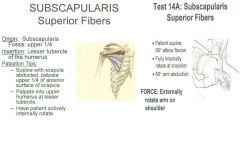
Subscapularis:
Superior Fibers |
|
|
ROM Test:
•Test 4: 90/90 Internal Rotation •Test 13: Humeral Extension, Abduction and Internal Rotation Muscle Test: 14B •Patient supine, 90º elbow flexion •Fully internally rotate, 80º abduction Tester: •FORCE: Externally rotate arm on shoulder Palpation/Function: •Treat ALL if one is weak. •Subscapularis Function: Internally rotates and adducts arm. •Holds head of humerus in glenoid (depression). •Depresses humerus in abduction against pull of deltoid. •Pulls the head of humerus posteriorly, offsetting the muscles which pull into anterior/superior glide. •Provide anterior gleno-humeral stability. •Many times, overpowered by the larger internal rotators (lat & pec major). •Most activity in 0-90º of abduction, as deltoid no longer pulls: it relaxes also •If tight: will limit function of Supination which can impair function in the elbow, wrist and hand. Scapula (Upper 2nd ¼ of Anterior Surface) •Supine with scapula abducted, palpate upper 2nd ¼ of anterior surface of scapula (or have them lie on side, put arm on your shoulder, reach arm to the medial border of scapula & curl under all the way around). •Can protract scapula, come anterior to scapula & lat. Come down and in onto the anterior surface of the scapula. Fill in as much as possible. Don’t come straight at armpit, come lower and angle up into the scapula, come in between lat and ribs and angle up and in to get the upper portion. •Slide in & out of scapula, don’t just stay in there. Lesser Tubercle of Humerus •Palpate into upper humerus at lesser tubercle. •Come into the humerus, under the deltoid and Lat •Or can find Bicep tendon, come on medial aspect, through the deltoid and find the lesser tubercle. •Have patient actively internally rotate. |
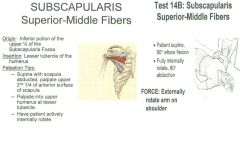
Subscapularis:
Superior-Middle Fibers |
|
|
ROM Test:
•Test 4: 90/90 Internal Rotation •Test 13: Humeral Extension, Abduction and Internal Rotation Muscle Test: 14C •Patient supine, 90º elbow flexion •Fully internally rotate at shoulder •110º abduction on arm Tester: •FORCE: Externally rotate arm on shoulder Palpation/Function: •Treat ALL if one is weak. •Subscapularis Function: Internally rotates and adducts arm. •Holds head of humerus in glenoid (depression). •Depresses humerus in abduction against pull of deltoid. •Pulls the head of humerus posteriorly, offsetting the muscles which pull into anterior/superior glide. •Provide anterior gleno-humeral stability. •Many times, overpowered by the larger internal rotators (lat & pec major). •Most activity in 0-90º of abduction, as deltoid no longer pulls: it relaxes also •If tight: will limit function of Supination which can impair function in the elbow, wrist and hand. Scapula (Upper 3rd ¼ of Anterior Surface) •Supine with scapula abducted, palpate upper 3rd ¼ of anterior surface of scapula (or have them lie on side, put arm on your shoulder, reach arm to the medial border of scapula & curl under all the way around). •Can protract scapula, come anterior to scapula & lat. Come down and in onto the anterior surface of the scapula. Fill in as much as possible. Don’t come straight at armpit, come lower and angle up into the scapula, come in between lat and ribs and angle up and in to get the upper portion. •Slide in & out of scapula, don’t just stay in there. Lesser Tubercle of Humerus •Palpate into upper humerus at lesser tubercle. •Come into the humerus, under the deltoid and Lat •Or can find Bicep tendon, come on medial aspect, through the deltoid and find the lesser tubercle. •Have patient actively internally rotate. |
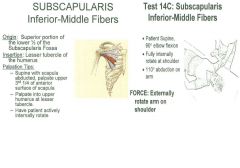
Subscapularis:
Inferior-Middle Fibers |
|
|
ROM Test:
•Test 4: 90/90 Internal Rotation •Test 13: Humeral Extension, Abduction and Internal Rotation Muscle Test: 14D •Patient supine, 90º elbow flexion •Abduct 125º, full internal rotation Tester: •FORCE: Externally rotate arm on shoulder Palpation/Function: •Treat ALL if one is weak. •Subscapularis Function: Internally rotates and adducts arm. •Holds head of humerus in glenoid (depression). •Depresses humerus in abduction against pull of deltoid. •Pulls the head of humerus posteriorly, offsetting the muscles which pull into anterior/superior glide. •Provide anterior gleno-humeral stability. •Many times, overpowered by the larger internal rotators (lat & pec major). •Most activity in 0-90º of abduction, as deltoid no longer pulls: it relaxes also •If tight: will limit function of Supination which can impair function in the elbow, wrist and hand. Scapula (¼ of Anterior Surface into Inferior Angle) •Supine, with scapula abducted, palpate ¼ of anterior surface of scapula into inferior angle. •Can protract scapula, come anterior to scapula & lat. Come down and in onto the anterior surface of the scapula. Fill in as much as possible. Don’t come straight at armpit, come lower and angle up into the scapula, come in between lat and ribs and angle up and in to get the upper portion. •Slide in & out of scapula, don’t just stay in there. Lesser Tubercle of Humerus •Palpate into upper humerus at lesser tubercle. •Come into the humerus, under the deltoid and Lat •Or can find Bicep tendon, come on medial aspect, through the deltoid and find the lesser tubercle. •Have patient actively internally rotate. |
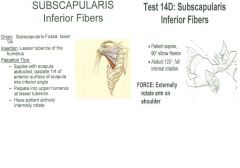
Subscapularis:
Inferior Fibers |
|
|
ROM Test:
•Test 13: Humeral Extension, Abduction and Internal Rotation •Test 21: Elbow Flexion, Wrist Extension and Supination Muscle Test: 15A •Patient supine •Supination, flex shoulder until arm can no longer remain supinated •Some bend in elbow is ok Tester: •FORCE: Extend shoulder through sagittal plane. (push towards feet) Palpation/Function: •Biceps Brachii Function: Flexes humerus. •Flexes and abducts humerus if externally rotated. •Flexes elbow. •2 divisions: Long Head & Short Head Biceps Tendon •Supine, with elbow flexed, rotate arm to feel bicep tendon in groove, palpate superior aspect of tendon. •Follow tendon of bicep up under the acromion process, as high as you can. •Anterior and inferior to acromion process Radial Tuberosity •Have client actively flex elbow, follow tendon into attachment on radial tuberosity. •Supinate and follow tendon to tuberosity on the radius. If they aren’t supinated you can’t get to bicep tendon. Have them relax and follow the tendon down onto the tuberosity of the radius. |
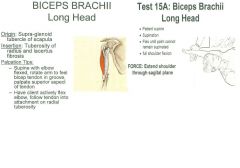
Biceps Brachii: Long Head
|
|
|
ROM Test:
•Test 13: Humeral Extension, Abduction and Internal Rotation •Test 17: Elbow Flexion with Supination •Test 19: Elbow Flexion, Wrist Flexion and Supination •Test 21: Elbow Flexion, Wrist Extension and Supination Muscle Test: 15B •Patient supine, full elbow flexion •Supinate forearm on arm, full flexion Tester: •FORCE: Extend elbow through sagittal plane •Grab at wrist. Palpation/Function: •Biceps Brachii Function: Flexes humerus. •Flexes and abducts humerus if externally rotated. •Flexes elbow. •2 divisions: Long Head & Short Head Corocoid Process •Supine, palpate into armpit following tendon into corocoid. Radial Tuberosity •Have client actively flex elbow, follow tendon into attachment on radial tuberosity. •Supinate and follow tendon to tuberosity on the radius. If they aren’t supinated you can’t get to bicep tendon. Have them relax and follow the tendon down onto the tuberosity of the radius. |
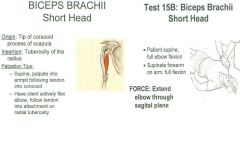
Biceps Brachii: Short Head
|
|
|
ROM Test:
•Test 3: Active Protraction •Test 8: Horizontal Adduction with External Rotation Muscle Test: 15C •Patient supine, elbow fully extended •45º humeral abduction •Externally rotate humerus •Flex arm on shoulder 10º Tester: •FORCE: Humeral Extension (push down) Palpation/Function: •Flexes the shoulder: (GH-Joint) •Adducts shoulder. •External rotation Corocoid Process •Follow short head of bicep into attachment at corocoid process. •Angle toward corocoid which is medial to the humerus and about at the bend of the clavicle, interior and anterior to the clavicle, follow split between deltoid and pec. •Follow line of deltoid angling medially. Humerus •Supine, with elbow flexed, abduct 45º and externally rotate humerus. •Actively adduct humerus to follow tendon into medial surface of humerus. •Medial aspect of humerus, take time, very sensitive, don’t compress an artery, opposite side of deltoid tuberosity. •Same size palpation as deltoid tuberosity. |
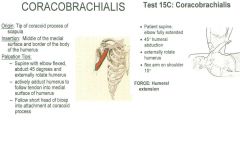
Coracobrachialis:
|
|
|
ROM Test:
•Test 16: Elbow Flexion with Pronation •Test 17: Elbow Flexion with Supination •Test 19: Elbow Flexion, Wrist Flexion and Supination Muscle Test: 16 •Patient supine, full elbow flexion •Pronate forearm: palm down (away from bicep) Tester: •FORCE: Extend elbow through sagittal plane. Palpation: •Pronation = Brachialis •Neutral = Brachioradialis •Supinated = Biceps Humerus (Anterior Surface) •Flex elbow to create slack on bicep •Start medial to where deltoid is and lateral to where Coracobrachialis is. •Palpate through bicep onto anterior surface of humerus •Arm neutral, anterior lower half of humerus. •Can pull bicep out of way to help get on lower anterior surface. •Starting medial to where deltoid is. Coronoid Process (Ulna) •Contract bicep to follow tendon into Coronoid process of the ulna. •Come right along lower anterior half, deeper than the bicep attachment. •Keep them close to neutral while palpating. |
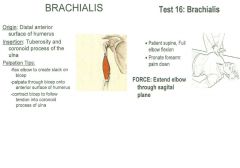
Brachialis:
|
|
|
ROM Test:
•Test 16: Elbow Flexion with Pronation Muscle Test: 17 •Patient supine, forearm neutral (palm in) •Full elbow flexion •Thumb towards shoulder Tester: •FORCE: Extend elbow through sagittal plane. Palpation: Humerus (Lower/Lateral 1/3) •Supine, palpate lower lateral 1/3 of humerus. •Anterior lateral lower humerus Radius (Lower/Lateral) •Palpate lower lateral portion of radius. •Put arm in 90º elbow flexion, neutral, and palpate on thumb side superior to wrist on the radius. |
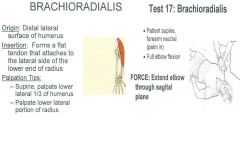
Brachioradialis:
|
|
|
ROM Test:
•Test 12: Humeral Extension •Test 14: Elbow Extension and Supination Muscle Test: 18A •Patient supine, 90º elbow flexion •Arm at side, extend arm on shoulder 20º •Arm off table •Palm in neutral •TEST 2: Extend Arm and do the same thing Tester: •FORCE: Flex shoulder through sagittal plane (push from elbow, directly up) •Palm Neutral = Long Head •Palm down (Back of hand toward Bicep) = Lateral Head •Palm Up (Palm toward Bicep) = Medial Head Palpation/Function: •When someone flexes their tricep the horseshoe area in the middle is the long head. •Long Head Function: Extends and adducts humerus. •With arm hanging: will pull humerus into acromion. •Prevents it from being pulled out of socket. •Opposes pull of lat and pec major from pulling humerus down and out of glenoid as they all adduct together. Infra-Glenoid Tubercle •Prone with arm off table, have client actively extend elbow, follow tricep into infra-glenoid tubercle. •Find lateral aspect of scapula to the armpit, & treat infra-glenoid tubercle. •Have them extend elbow to feel muscle. Tricep Horseshoe & Olecranon Process •Palpate inside horseshoe of tricep down to olecranon. •Have them extend elbow, find horseshoe & palpate up & in (filling in horseshoe). •Go to elbow and find olecranon. Hook into superior part of olecranon |
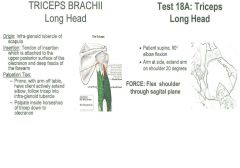
Triceps Brachii: Long Head
|
|
|
ROM Test:
•Test 14: Elbow Extension and Supination Muscle Test: 18B •Patient supine, 90º elbow flexion •Palm up, supinated position Tester: •FORCE: Flex elbow through sagittal plane (push straight against wrist into flexion). •Palm Neutral = Long Head •Palm down (Back of hand toward Bicep) = Lateral Head •Palm Up (Palm toward Bicep) = Medial Head Palpation: •When someone flexes their tricep the big lower piece that is medial to body (closer to armpit) is the medial head. Humerus & Medial Tricep Belly •Prone, palpate posterior medial lower ½ of the humerus wrapping anterior to medial belly. •Pick tricep head up come onto posterior aspect about the deltoid tuberosity down onto the posterior aspect, picking tricep head up coming into the humerus working down. Get to posterior surface. •Arms hanging off table •Lower ½, posterior/medial into the humerus Olecranon Process •Go to elbow, find tip of olecranon process. |
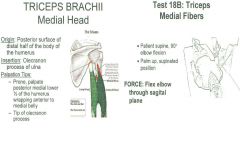
Triceps Brachii: Medial Head
|
|
|
ROM Test:
•Test 14: Elbow Extension and Supination Muscle Test: 18C •Patient supine, 90º elbow flexion •Palm down, pronated position. Tester: •FORCE: Flex elbow through sagittal plane. •Palm Neutral = Long Head •Palm down (Back of hand toward Bicep) = Lateral Head •Palm Up (Palm toward Bicep) = Medial Head Palpation: •When someone flexes their tricep the big piece at the top easiest to notice (which sits laterally) is the lateral head. Humerus & Lateral Tricep Belly •Prone, palpate posterior lateral upper ½ of the humerus wrapping anterior to lateral belly. •Follow deltoid, get upper lateral half on backside of humerus, pulling the deltoid out of the way getting on posterior humerus. •Get superior/medial to deltoid, wrapping anterior to lateral belly. Pulling deltoid out of way to get to upper/lateral ½ of humerus. Olecranon Process •Go to elbow, find tip of olecranon process. |

Triceps Brachii: Lateral Head
|
|
|
ROM Test:
•Test 14: Elbow Extension and Supination Muscle Test: 25 •Patient supine, extend and supinate forearm. Tester: •FORCE: Into Pronation with elbow fully extended. •Maintain extension & push into Pronation •Sandwich the hand and rotate inward Palpation/Function: •Elbow extensor. Lateral Epicondyle of Elbow •Prone, palpate posterior medial surface of the lateral Epicondyle. •Palpate lateral Epicondyle down across to the olecranon Ulna (Upper/lateral ridge) •Palpate along upper lateral ridge of the ulna. •Sink into lateral posterior surface of upper ¼ of the ulna. |
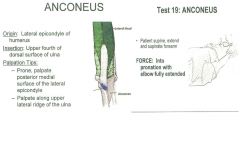
Anconeus:
|

